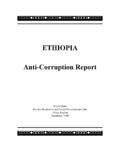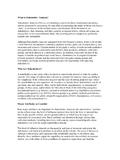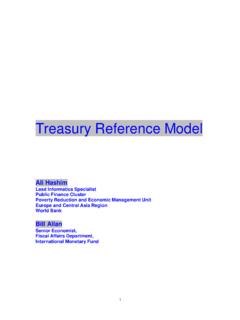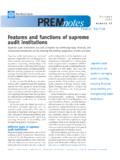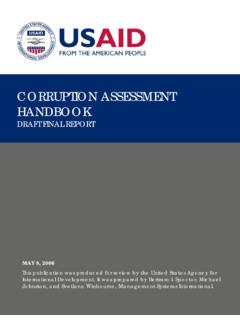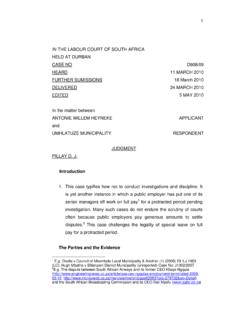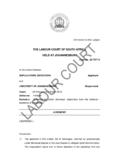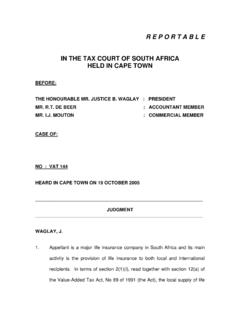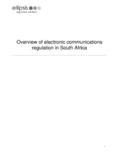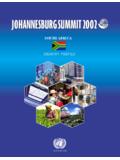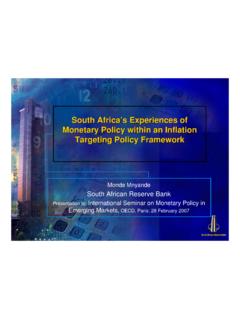Transcription of 13. Property Taxation in South Africa1 - World Bank
1 113. Property Taxation in South Africa1 The population of South africa is 44 million. The country is organized into 9 provinces, 6 single-tier metropolitan municipalities, 50 district municipalities, and 228 local councils (within the district municipalities). This new municipal structure came into effect in December 2000 through the amalgamation of primary-tier urban and rural municipalities into new local municipalities. The Property tax (known as rates on Property ) is a local tax (provinces are prohibited from levying Property tax) and it is levied by municipalities in all provinces. In metropolitan areas, the metropolitan local councils levy and collect Property rates; in non-metropolitan areas, only urban municipalities levy Property taxes. National and provincial governments regulate how the Property tax is charged, assessed, and collected, however.
2 Within the former white local authorities, the Property tax was an important tax. Generous rebates were granted to residential taxpayers, shifting much of the burden onto commercial and industrial properties. In contrast, the former black municipalities did not levy Property taxes and relied largely on grants from the central government. The absence of a Property tax reflected apartheid policies which prohibited black land ownership outside of the homelands. In 1993, the Property tax bases of the former white local authorities were extended to former black local authorities to achieve a uniform structure throughout the jurisdiction of any local government council. The Property tax is still being phased in some black township The Property Rates Bill (published in August 2000), if implemented, would create a nation-wide legal and regulatory framework for valuing Property and levying tax rates.
3 Specific provisions of this Bill are mentioned under the tax base and tax rates sections below. Revenue Importance Table 1 indicates that the Property tax is an important source of revenue to local governments (metropolitan, district, and local councils), accounting for 21 percent of their revenues. Property taxes are used for funding those services that are not fully supported by fees, for example, general government, recreation, street lighting, and libraries. 1 Prepared by Enid Slack, Enid Slack Consulting, Toronto. 2 Property taxes are at present not applied in most rural areas, particularly tribal land for many reasons, including the fact that there are few services provided in these areas (Riel Frantzen, Local Government and Property Tax Reform in South africa , Land Lines (Lincoln Institute of Land Policy), May 2000, p.)
4 5). For discussion of the potential for land Taxation in rural South africa , see Johan van Zyl and Nick Vink, An Agricultural Economic View on Land Taxation in South africa , Journal of Property Tax Assessment and Administration, vol. 1 ( , 1995), pp. 101-21. 2 Non- Property tax revenues include gross utility fees from trading services (surcharges on specific municipal services such as electricity, water, sewerage, and refuse removal, with electricity making up the largest share). Historically, these fees have been the largest source of municipal revenue. It is anticipated, however, that the introduction of new directions for the provision of water and electricity will affect the profits on these services and the municipal revenues. This means that Property taxes will likely become more significant in the future. Transfers include conditional and unconditional grants.
5 RSC levies are taxes on businesses. Although, on average, they account for only 7 percent of municipal revenues, they represent a higher percentage of the revenue in metropolitan municipalities than in smaller municipalities. RSC levies are the primary source of revenue for district municipalities. Two thirds of these levies are based on turnover. The remaining one third is a regional establishment levy on the annual value of the payroll. Other municipal revenues include interest on investment, non-trading services, fees and charges, and fines. Table 1: Distribution of Municipal Revenue Sources, South africa , 1999-2000 Revenue Percent of Total Municipal Revenues Property Rates (Taxes) Utility Fees Regional Service Council (RSC) Levies Other Total Own-Source Revenues Transfers Total Revenues 21 32 7 32 92 8 100 Source: Republic of South africa .
6 2001. Intergovernmental Fiscal Review 2001. National Treasury, p. 147. The Tax Base The Property tax is levied on owners of immovable Property . All land (residential, commercial, industrial, agricultural) and any improvements to the land are rateable. The Property tax base also includes land owned by local government and vacant land. Rural properties (land outside the boundaries of urban centres) are not currently included in the tax base. Under the proposed legislation, however, the tax will likely be extended to previously unrated rural, agricultural, and government Property . Capital value is used as the basis for valuation. Local government councils have the option to choose between at least two of the following tax bases: 3 site rating (rating on unimproved land only); flat rating (rating the improved value of the land); and composite or differential rating (rating both land and improvements but at different rate levels).
7 Currently, the use of these three tax bases is evenly split among local councils. No matter which base is used, the roll includes the value of the land, the improvements, and the total Property value. Under the proposed legislation, all properties would be required to use total improved value of Property as the tax base by July 1, It would also require comprehensive re-valuations which would mean that taxes would be at a value that is closer to market value for those properties that have appreciated or depreciated significantly. Unimproved land value is defined as the amount which such land or right in the land would have realized if sold on the date of valuation in the open market by a willing seller to a willing buyer. Site value is defined in the same way except that it is assumed that the improvements had not been made.
8 The value of improvements is determined by subtracting the site value of land from the improved value. The comparable sales method is used to value the land. This method attempts to estimate the price that would be paid by a willing buyer to a willing seller in an arm s length transaction. To value the improvements, two methods are used: subtract site value from the improved land value (the most commonly used method) or value buildings at replacement cost less depreciation. Some exemptions and other tax relief measures are provided in all 9 provinces but they are few in number. Exemptions include religious institutions (but only those used exclusively for religious purposes). Unlike in many other countries, state-owned properties are not exempt from the Property tax but they do receive a 20 percent rebate. Tax relief is granted through grants-in-aid, rebates, differential tax rates, or remission of some or all of the tax payable.
9 Rebates are used most widely for residential properties for which rebates of 40 percent are not uncommon. Additional rebates may be granted to disabled persons, pensioners, or low-income taxpayers. 3 An interesting comment on this prospect appears in a recent paper by an advocate of site-value Taxation : Despite the fact that site-value rating has proved to be so is unlikely to be legislated as the preferred system. The idea of a tax so broadly based as to include everybody in its net seems to weigh more heavily than do traditional concepts of equity as proportionate to either benefits received or ability to pay ( Dunkely, Republic of South africa , in Andelson, ed., Land-Value Taxation around the World (3rd ed.; Malden, MA: Blackwell, 2000), p. 309). 4 Tax Rates The rate is set to make up shortfall between expenditure requirements and revenue from other sources.
10 Local councils are not permitted to levy differential rates on different classes of Property . Rather, uniform or flat rates are used. In lieu of differential Property tax rates, local councils can grant rebates or relief measures to different Property types. Differential rates are only available for land held for specific uses such as agriculture or mining. In some provinces, a maximum rate is set by the provincial government. Where the tax base includes both land and improvements, the rate on land is higher than the rate on improvements. Under the proposed legislation, decisions about differential rating of different categories of Property , as well as exemptions and rebates, would be left to municipal councils. Each council would be required to adopt a Property rates policy and to reflect the implicit cost of all exemptions and rebates as budget expenditures.

